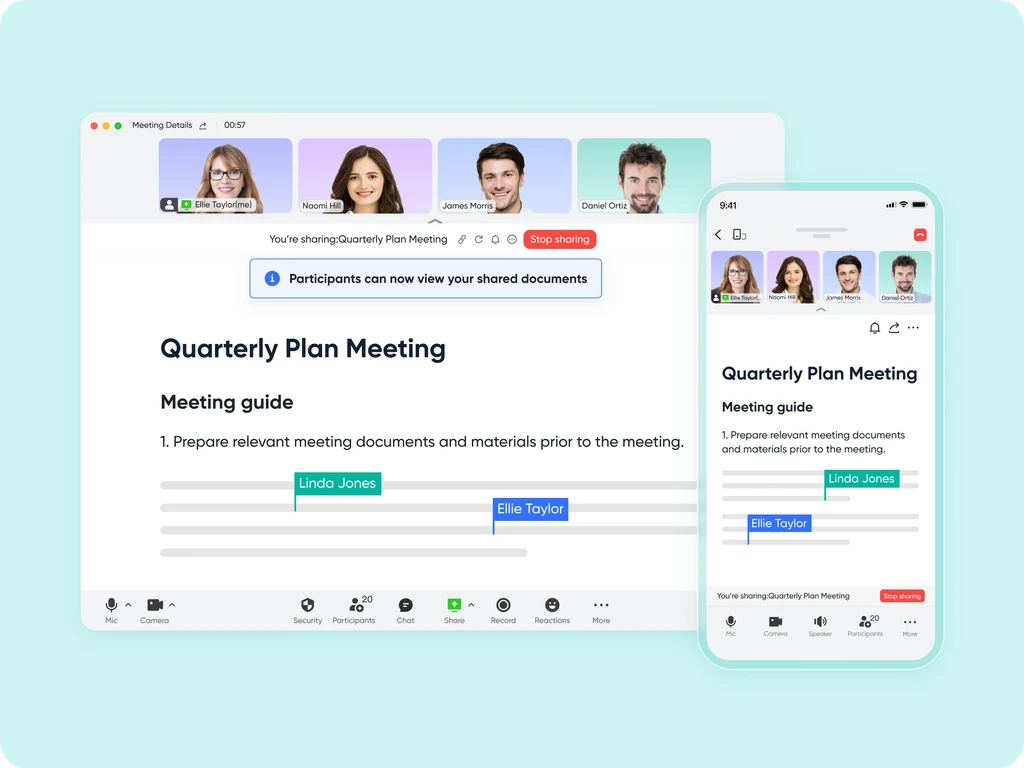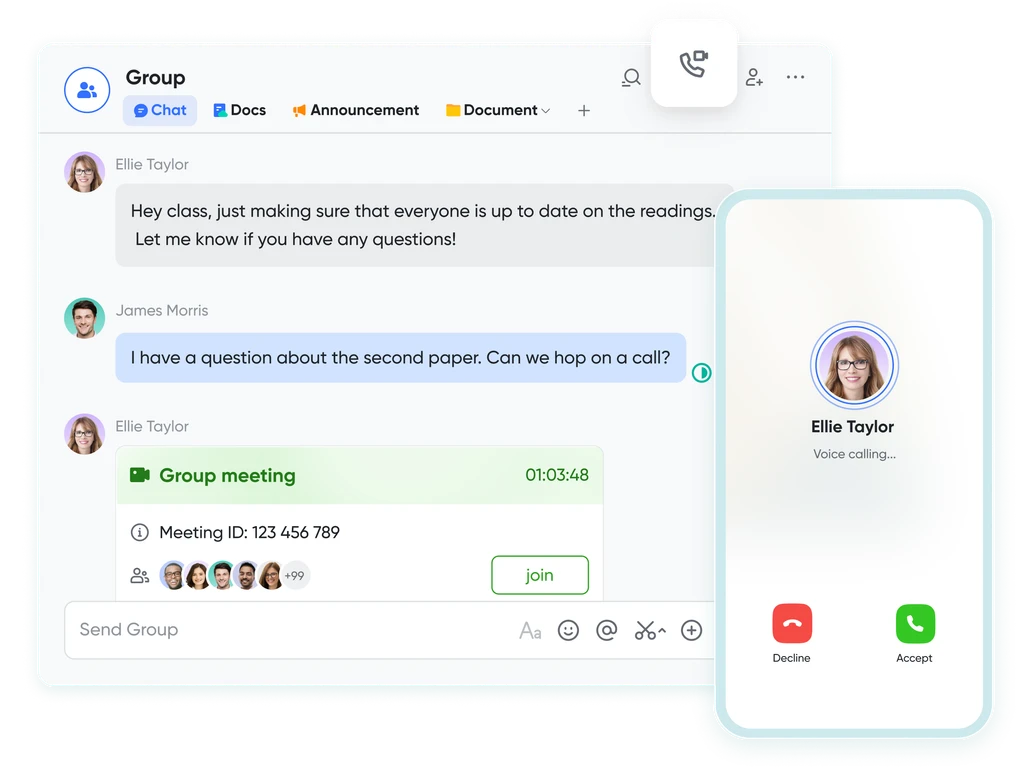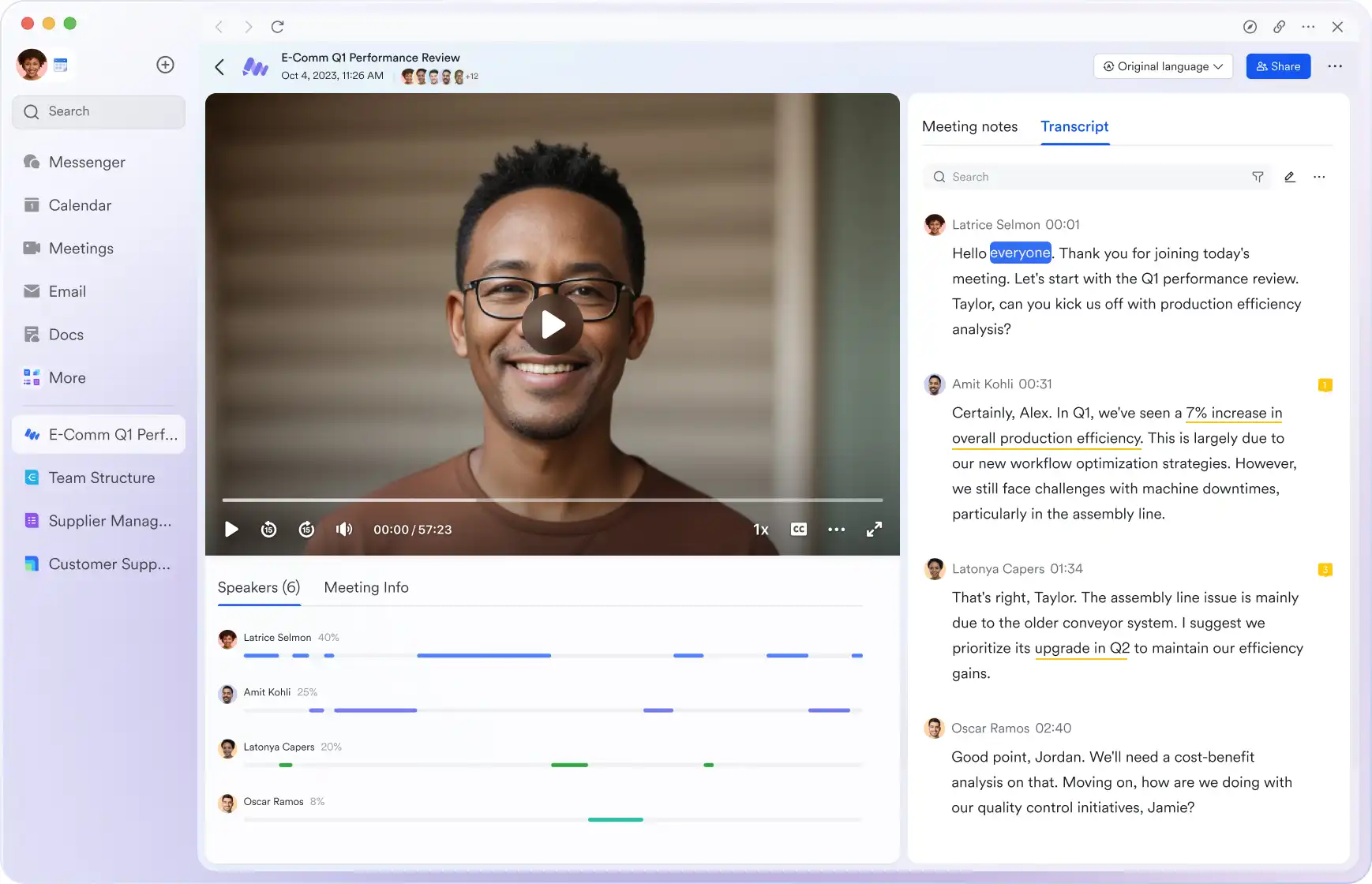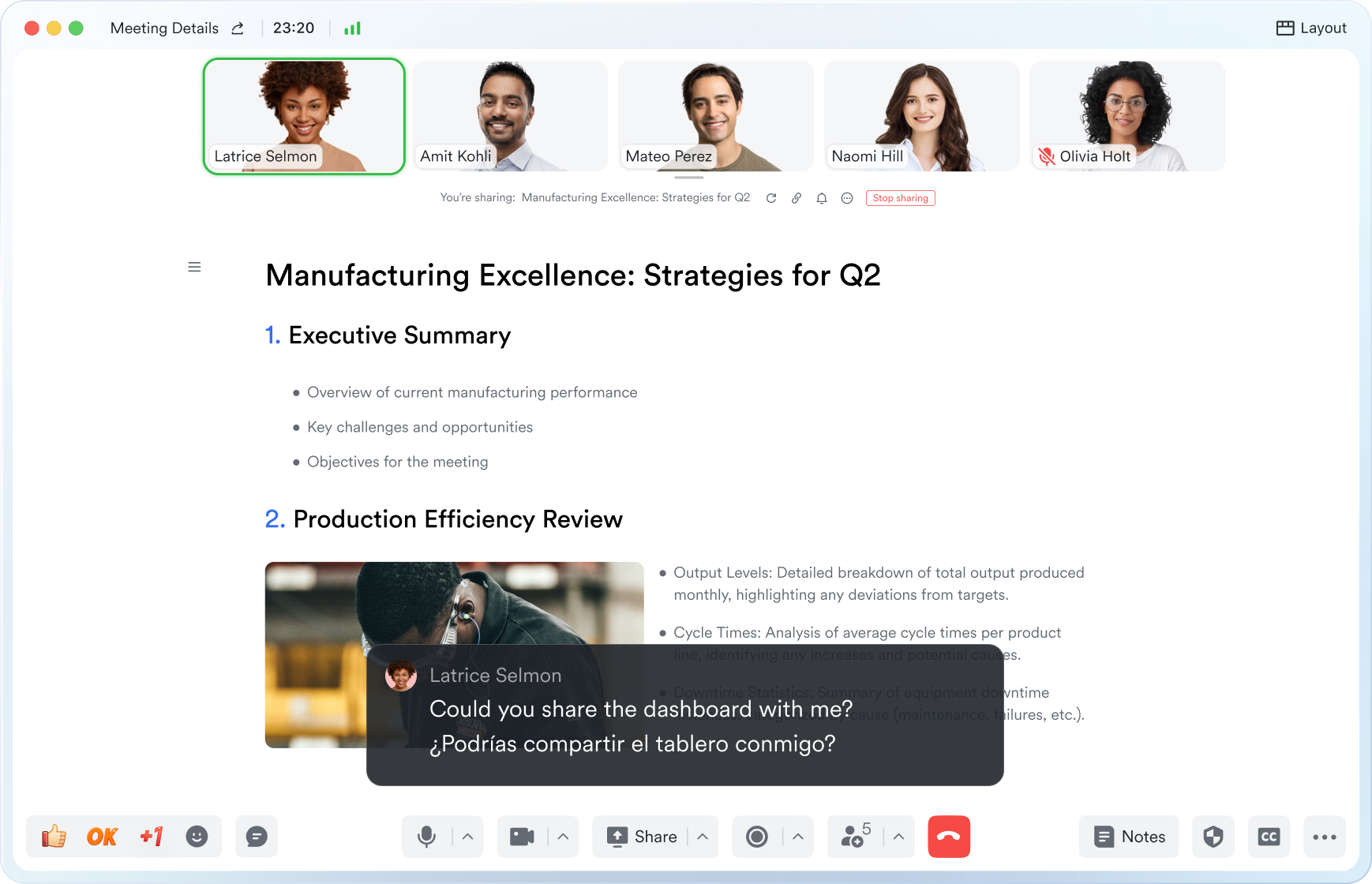Feedback Meeting
This guide will walk you through the essential elements of use feedback meeting to keep your attendees aligned and engaged.
Try Lark for Free
In the contemporary business environment, the significance of effective feedback exchange cannot be overstated. As professionals navigate the complexities of their roles, continuous feedback serves as a catalyst for growth and improvement. In this guide, we will explore the essential elements of feedback meetings, offering actionable strategies and valuable insights to help professionals navigate and master these critical interactions in 2024.
Use Lark Meetings to turn meetings into true collaborative experiences.
What is a feedback meeting?
A feedback meeting is a designated session where individuals or teams come together to exchange constructive feedback, discuss performance, and set goals for improvement. It provides a platform for open communication, enabling participants to gain valuable insights into their strengths, areas for development, and overall performance. The primary objective of a feedback meeting is to foster a culture of continuous improvement and provide a structured framework for addressing professional growth.
Goals of feedback meeting
The fundamental goals of a feedback meeting revolve around fostering individual and collective growth. These include:
- Promoting Self-Awareness: Helping individuals gain clarity on their strengths, weaknesses, and developmental areas.
- Enhancing Performance: Identifying strategies to amplify performance and achieve professional objectives.
- Encouraging Dialogue: Creating an environment that encourages open and constructive dialogue between participants.
- Setting Clear Objectives: Establishing clear and actionable goals for improvement and development.
Who should attend feedback meeting?
Key Stakeholders
- Employees: Both individual contributors and team members who are the recipients of feedback.
- Managers and Supervisors: To provide and discuss feedback with their direct reports.
- HR Representatives: Facilitating the meeting and addressing organizational concerns related to employee development.
- Peers: In cases where peer feedback is integral to the improvement process.
In essence, the participation of individuals who have a direct or indirect impact on the recipient's performance and growth is crucial for the success of a feedback meeting.
Related:
Unlock the Power of Webinars: A Comprehensive Guide to Boost Your Business | Lark Blog | Lark BlogLearn more about Lark x Meetings
Topics, agenda, and structure of feedback meeting
Crafting a Comprehensive Agenda
A well-structured agenda is the cornerstone of an effective feedback meeting. Key components of the agenda should include:
- Introduction and Context Setting: Providing an overview of the meeting's purpose and setting the tone for constructive dialogue.
- Feedback Exchange: Allotting time for the exchange of feedback between relevant parties.
- Goal Setting: Discussing and setting clear and measurable objectives for performance improvement.
- Action Planning: Outlining actionable steps and strategies to achieve the identified goals.
- Follow-Up and Review: Establishing a framework for follow-up meetings and progress tracking.
Various Meeting Structures
Depending on the scope and nature of the feedback, several meeting structures can be employed, including:
- One-on-One Meetings: Ideal for personalized feedback and goal setting discussions.
- Team Feedback Sessions: Beneficial for facilitating collective performance discussions and setting team-oriented goals.
- 360-Degree Feedback Meetings: Involving feedback from superiors, subordinates, peers, and self-evaluations for a comprehensive view of performance.
Key Topics to Address
- Strengths and Achievements: Recognizing and reinforcing positive outcomes and contributions.
- Development Areas: Addressing areas that require improvement and offering constructive feedback.
- Career Aspirations: Discussing professional aspirations and aligning them with organizational objectives.
- Training and Development Needs: Identifying skill gaps and developmental opportunities.
The above structure and topics ensure a well-rounded and productive feedback meeting.
Learn more about Lark x Meetings
How often does a feedback meeting occur?
The frequency of feedback meetings varies based on the organization's culture, the nature of roles, and individual needs. However, in most cases, feedback meetings occur at regular intervals, such as quarterly, semi-annually, or annually. This periodic structure ensures that there are consistent touchpoints for performance evaluation and improvement discussions.
Key differences between feedback meeting and another similar meeting
Performance Review Meetings
Feedback Meetings
- Focus: Primarily on providing constructive feedback and setting goals for improvement.
- Nature: Often more informal, fostering open dialogue and two-way communication.
- Time Frame: Can occur more frequently to address immediate performance and development needs.
Performance Review Meetings
- Focus: Evaluating historical performance and discussing progress against set goals and objectives.
- Formality: Often follows a formal structure, involving documented reviews and assessments.
- Frequency: Typically aligned with specific review cycles, such as annual or bi-annual evaluations.
While both serve distinct purposes, feedback meetings prioritize continuous improvement and proactive goal setting, distinguishing them from traditional performance reviews.
Learn more about Lark x Meetings
Three practical examples of feedback meetings
Example 1:
Example 1:
Scenario: An employee exhibits a significant improvement in their sales performance over the quarter.
Outcome: Through a feedback meeting, the employee receives recognition for their progress and is encouraged to set stretch targets for continued growth.
Example 2:
Example 2:
Scenario: A team undergoes a challenging project, resulting in varied performance outcomes.
Outcome: A team feedback session is conducted, encouraging open discussions on individual and collective contributions, leading to areas for mutual support and development.
Example 3:
Example 3:
Scenario: A manager seeks feedback from their team on leadership and communication effectiveness.
Outcome: The manager receives constructive feedback, which leads to the identification of specific development areas and action plans for improvement.
Common pitfalls of a feedback meeting
Lack of Preparation
One of the common pitfalls is inadequate preparation, leading to disorganized discussions and unclear outcomes.
Imbalanced Feedback Exchange
When meetings lean towards overly critical or excessively positive feedback, it hampers the purpose of balanced and constructive discussions.
Limited Follow-up and Support
Without a structured follow-up plan, meetings may fail to yield tangible results, leading to stagnant or unaddressed developmental areas.
By avoiding these pitfalls, professionals can optimize the effectiveness of their feedback meetings, driving meaningful improvement and growth.
Related:
Master the Art of Meeting Notes with Lark for Enhanced Collaboration | Lark Blog | Lark BlogLearn more about Lark x Meetings
Dos and don'ts of a feedback meeting
| Do's | Don'ts |
|---|---|
| Actively listen to the feedback provided. | Avoid using generalized or vague feedback. |
| Offer specific and actionable improvement suggestions. | Refrain from making personal or subjective comments. |
| Emphasize positive achievements and contributions. | Resist the temptation to dominate the feedback exchange. |
| Encourage open and respectful dialogue. | Avoid interrupting or dismissing the feedback shared. |
These dos and don'ts serve as guiding principles for fostering a constructive and balanced feedback meeting environment.
What makes a virtual feedback meeting successful?
In the digital landscape of 2024, virtual feedback meetings play a crucial role in ensuring continuous and effective communication. Key factors contributing to the success of virtual feedback meetings include:
- Technology Integration: Leveraging advanced communication tools and platforms for seamless interactions.
- Clear Communication Guidelines: Establishing protocols for virtual discussions, ensuring clarity and understanding.
- Interactive Engagement: Utilizing interactive features to encourage active participation and engagement.
- Data Security: Implementing robust data security measures to safeguard sensitive feedback and discussions.
By embracing and optimizing virtual feedback meetings, professionals can bridge geographical barriers and facilitate meaningful interactions while ensuring a high level of engagement and impact.
Related:
Master the Art of Meeting Notes with Lark for Enhanced Collaboration | Lark Blog | Lark BlogLearn more about Lark x Meetings
Typical takeaways of the feedback meeting
The typical takeaways from a feedback meeting encompass a broad spectrum of professional and personal growth:
- Clarity on Development Areas: Individuals gain insights into areas requiring improvement and strategies to address them.
- Motivation and Recognition: Acknowledgment of achievements and contributions fosters motivation and a sense of appreciation.
- Clear Action Plans: Establishment of clear and actionable steps to drive performance improvements.
- Enhanced Communication: Improved communication and understanding across teams and hierarchies.
These takeaways contribute to a culture of continuous improvement and professional development.
Questions to ask in the feedback meeting
For Recipients of Feedback
- What specific areas do you believe I should focus on for improvement?
- How do you perceive my contributions to the team's recent projects or initiatives?
For Providers of Feedback
- What aspects of my performance do you believe I should further leverage and build upon?
- How can I better support and align with the team's objectives and goals?
Learn more about Lark x Meetings
Conclusion
In conclusion, mastering effective feedback meetings is a cornerstone of professional development and growth in 2024. By leveraging the insights, best practices, and practical examples outlined in this comprehensive guide, professionals can navigate feedback meetings with confidence, foster meaningful interactions, and drive tangible outcomes for themselves and their teams.
Learn more about Lark x Meetings
Use Lark Meetings to turn meetings into true collaborative experiences.
A Game Changer for Feedback Meeting: Empower your team with Lark Meetings
In the fast-paced and dynamic world of modern business, effective communication and collaboration are crucial for success of Feedback Meeting. Here we introduce Lark Meetings to serve as a centralized hub for all communication needs.
Transform your meetings into collaborative endeavors

Leverage the potency of in-call document sharing, intelligent meeting minutes, and mobile-optimized features to enhance productivity collaboratively, irrespective of your location or schedule.
Seamlessly collaborate in real-time, across any device

Share live documents instead of just screen views. Participants can navigate and edit simultaneously within the video call window, even while on the move.
Shift your focus to engagement, not note-taking

Lark Minutes automatically converts video meetings into transcripts, facilitating easy viewing, searching, and collaborative editing. Stay in the loop asynchronously, even if you can't attend the live meeting. Lark Minutes for meeting minutes support translation into 10+ different languages.
Break language barriers in communication

Lark Meetings provide real-time translation for subtitles, allowing individuals from diverse backgrounds to express themselves in their native languages. Ensure every voice is heard, regardless of geographical location. Live subtitles currently support translations from English, Chinese, and Japanese to 10+ different languages. See more translation feature in Lark.
Connect with larger audiences
Host dynamic online meetings and events accommodating up to 1,000 participants, with the flexibility of up to 50 breakout sessions for intimate group discussions within the larger meeting context. Try more Lark features for free.








